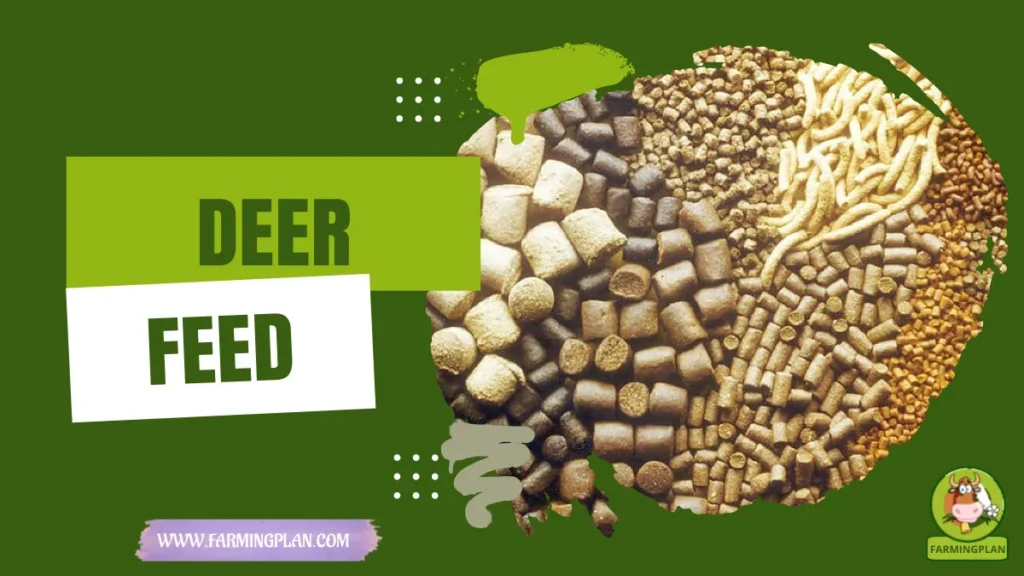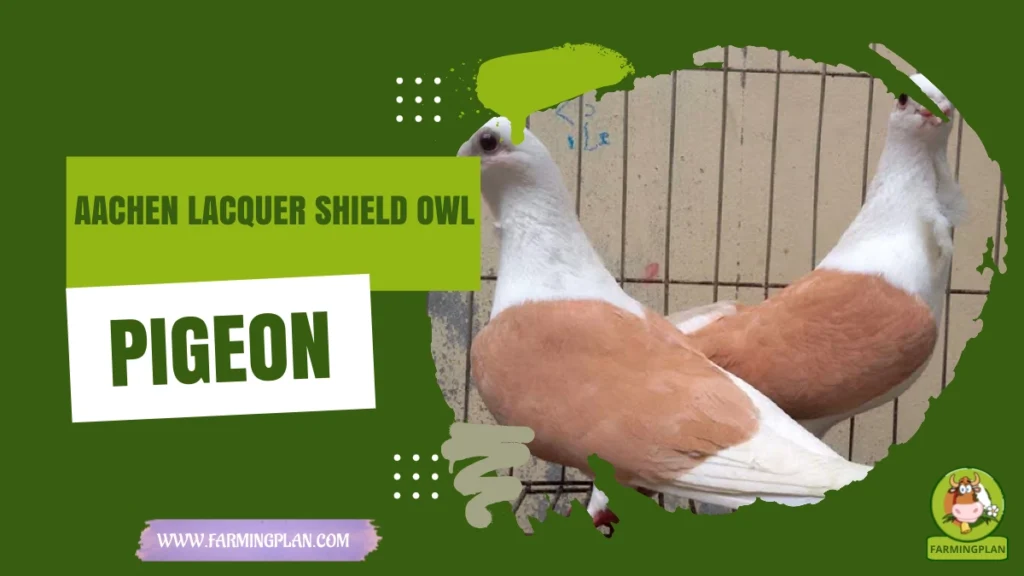If you’ve ever laid eyes on an Andalusian Horse, you’ll know exactly what I mean when I say—this breed turns heads. Known for their grace, power, and that unmistakable Spanish flair, these horses have been the darlings of riders and breeders for centuries. The Andalusian Horse isn’t just a showstopper—it’s one of the most versatile and kind-hearted breeds out there. Whether you’re a pet owner, a seasoned breeder, or someone who just loves majestic animals, this beauty from the Iberian Peninsula has something to offer. In this guide, I’ll walk you through everything from its history to daily care. And don’t worry—I’m keeping it real, friendly, and down-to-earth, just like a chat between horse-loving friends.
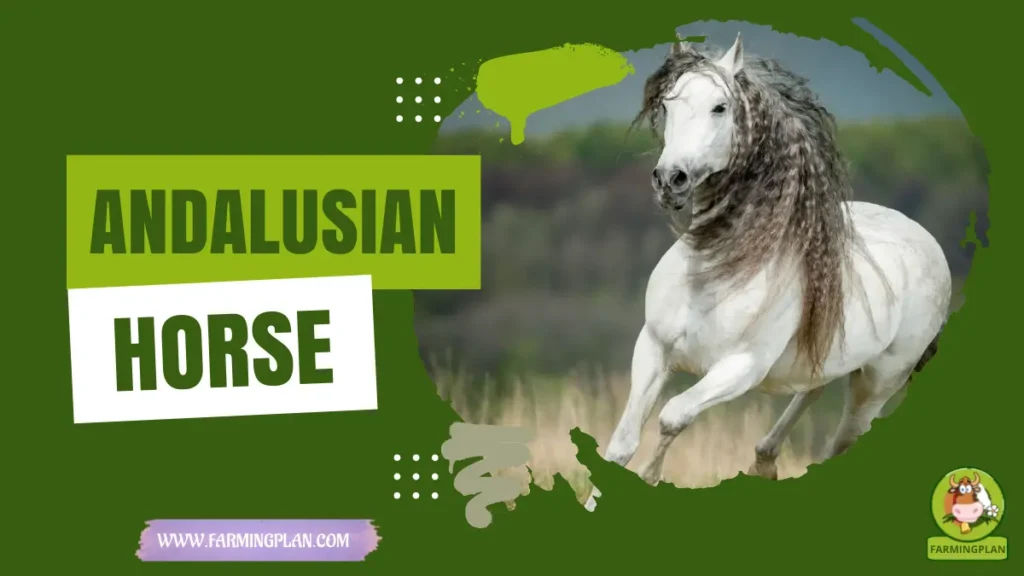
History & Origin of the Andalusian Horse
The Andalusian Horse has a rich and storied history that dates back to the 15th century in Spain, deep in the Iberian Peninsula. Back then, they were known as Iberian Saddle Horses and were highly prized by nobles, cavalrymen, and even kings. Their lineage, which includes oriental horses, Arabian, and Anglo-Arabian breeds, speaks to their endurance, elegance, and agility.

Over the centuries, they played a massive role as cavalry horses and war mounts. You’ll find mentions of them all over Europe in the 16th and 17th centuries. And even as time marched into the 19th and 20th centuries, selective breeding helped preserve their best traits. Today, Andalusian horse are recognized worldwide, with strong breed registries in places like the United States, Australia, and Europe, including the Lusitano Horse Association for their close cousins.
Read More: Morgan Horse: The Surprising Benefits You’ll Experience with This Powerful Breed
Characteristics and Colors of Andalusian Horses
Let’s talk looks—because this breed is nothing short of stunning. An Andalusian typically stands about 15.1 to 16.1 hands high, with a strong, muscular build and that classic arched neck that just screams royalty. These are compact horses, built for both power and beauty, and that’s a rare combo.
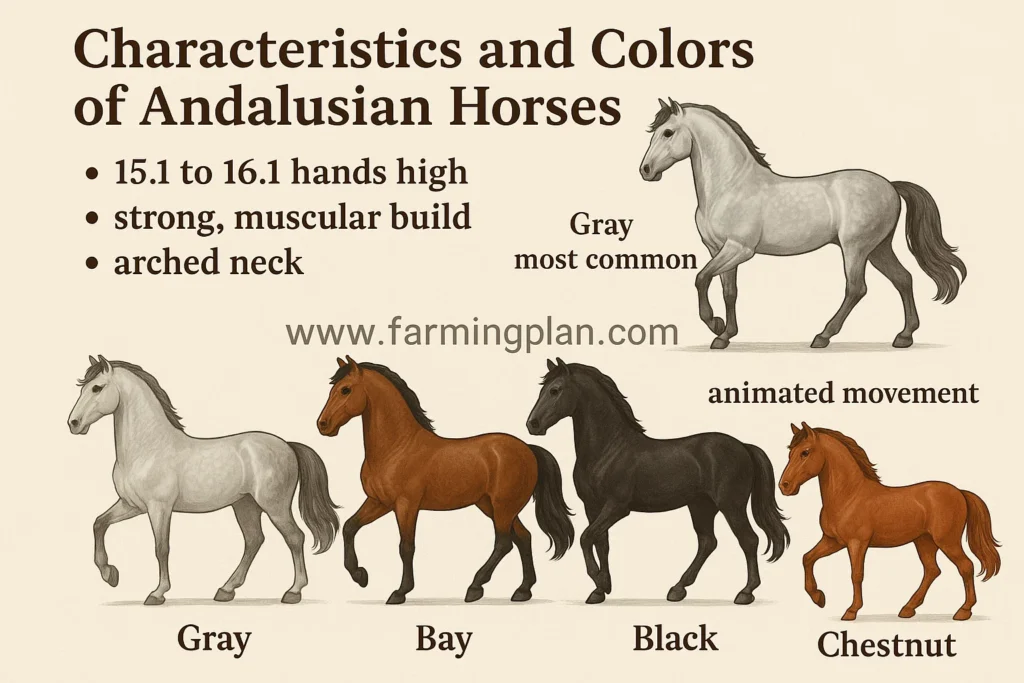
Color-wise, gray is the most common, but you’ll also find bay, black, and even the occasional chestnut. Their coats tend to lighten with age, so don’t be surprised if your gray Andalusian turns nearly white over time. The breed is split into Carthusian and non-Carthusian lines, each with slight differences in type. No matter what, these horses are known for their animated movement and flashy action, making them standout performers in any arena.
Temperament of the Andalusian Horse
I always tell folks—if you want a horse with heart and brains, go with an Andalusian. These horses are some of the kindest, calmest creatures I’ve worked with. They bond quickly with humans, making them ideal for pet owners, trainers, and even first-time horse handlers.
But don’t mistake their gentleness for laziness. They’re quick learners with a touch of fire, especially when they’re out performing. That’s why they’re so beloved in dressage circles. They’ve got that spark, but they’re not flighty. I’ve had Andalusians greet me at the gate like oversized dogs—sweet, curious, and completely lovable. They also do well in group environments and can hold their own among other stock horses or crossbred horses.
Read More: Forest Pony Horse: The Surprising Benefits You Didn’t Know You Were Missing
Food & Diet of the Andalusian Horse
Feeding an Andalusian isn’t complicated, but you do want to be smart about it. These horses have heavy horse blood, which means they’re naturally muscular—and they can put on weight quickly if you’re not careful. For a typical Andalusian, a diet consisting of high-quality grass hay as the base, with a small amount of grain or pelleted feed, and a scoop of alfalfa for more active horses, is a good starting point. It’s important to monitor their weight and adjust their diet accordingly.
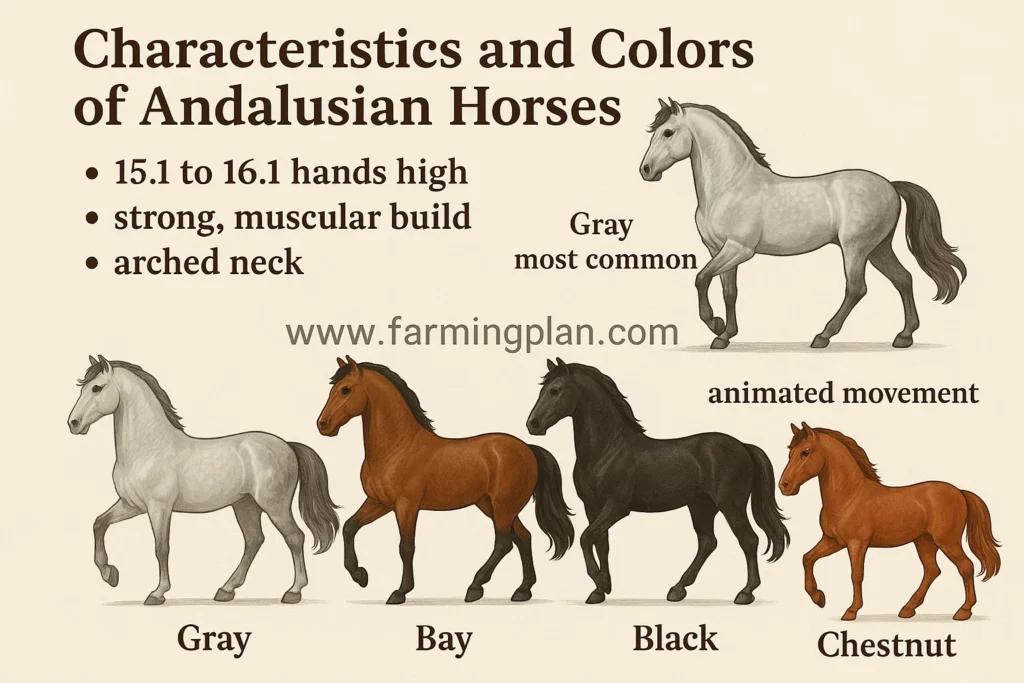
For instance, if your horse is gaining weight, you might want to reduce the amount of grain or feed. Keeping sugars low is crucial to avoid issues like metabolic syndrome. And please, skip the sweet treats—no candy, bread, or people food. Fresh water and free-choice salt blocks are must-haves, and a vitamin-mineral supplement can help round things out, especially if your pasture is lacking.
Uses & Purpose of the Andalusian Horse
The Andalusian Horse is a true all-rounder, showcasing its versatility in a variety of roles. From serving as cattle horses to pulling ornate carriages, and even performing in dressage routines that leave audiences in awe, these horses have proven that they are more than just a pretty face. They’ve even made their mark in the world of cinema, cementing their status as the action heroes of the horse world.
They’re also popular in parades and historical reenactments thanks to their regal look. In some areas, you’ll find breeders offering Andalusian horses for sale specifically for shows, trail riding, or breeding. Their combination of beauty, brains, and brawn makes them a go-to choice for so many different riders.
Read More: Thoroughbred Horse: Discover the Secrets Behind Their Unmatched Strength
Special Features
So, what makes Andalusians stand out from the crowd? First off, it’s that animated movement—there’s this kind of natural rhythm in how they move that’s just mesmerizing. Judges love it. Riders love it. Onlookers? Well, they usually whip out their phones to snap pics.
Their loyalty is another big plus. Once an Andalusian bonds with you, that’s it—you’ve got a friend for life. They’re also super responsive, which makes training a breeze if you know what you’re doing. Registries often recognize the breed for its flashy action, colors by registry, and even titles like “Lusitano Best Movement” in competitions.
Health Issues & Prevent of the Andalusian Horse
Just like any horse, Andalusians come with their own set of potential health hiccups. Laminitis and metabolic issues can be a problem, especially if they’re overfed or under-exercised. Since they have a sturdy frame, weight gain sneaks up fast if you’re not paying attention.
Proper care is crucial for the health and well-being of your Andalusian Horse. Regular hoof trims, annual dental checks, consistent grooming, and up-to-date vaccinations are all part of the package. Keep an eye out for signs of colic or stiffness, and always have a trusted vet on speed dial. With the right care, these beauties can live 20 to 25 years, and sometimes even longer!
“Give Your Andalusian The Right Space, Routine, And Love—And You’ll Earn A Partner With Grace, Heart, And Hooves That Dance With Pride.
Step-by-Step Pet Owner Care Guide
Caring for an Andalusian Horse takes more than love—it takes a plan. This easy-to-follow care guide gives you the exact steps I use to keep my Andalusians healthy, happy, and thriving. From setting up the perfect paddock to forming a lifelong bond through grooming and gentle training, I’ve laid it all out so you can give your horse the best life possible.
Step 1: Set Up a Safe, Spacious Living Area
Andalusians need space to stretch, play, and just be horses. I always start with at least a 1-acre paddock per horse, ideally more if you’ve got the room. I prefer pipe or wood fencing that’s at least 5 feet high—these horses are athletic and can clear low fences if spooked. Smooth wire fencing can work too, but skip barbed wire completely. Trust me, it’s not worth the vet bill.
Add a well-ventilated shelter or run-in shed for shade and protection from rain or snow. Inside their stall, I use dust-free pine shavings or straw bedding, which keeps their joints comfortable and hooves dry. Also, walk your paddock regularly to remove any toxic weeds like buttercup, ragwort, or bracken fern. A clean water trough, automatic waterer, and drainage that prevents standing mud will keep your horse healthier and way happier.
Step 2: Feed a Balanced Diet and Provide Clean Water
Feeding an Andalusian is part science, part observation. I feed 2–2.5% of their body weight in hay per day—usually a mixed grass hay that’s free of dust and mold. If your horse is working or in training, a slow transition to a low-starch, high-fiber concentrate gives them the extra energy they need without risking metabolic issues.
I check their water troughs twice daily. These horses drink 5 to 10 gallons of water per day, more during summer. I also keep loose salt and trace mineral blocks in the barn—they’ll lick what they need. And every two weeks, I run a quick body condition score check to make sure they’re not gaining or losing weight too fast. A belly can sneak up on these chunky charmers.
Step 3: Groom Daily and Watch for Health Red Flags
Grooming your Andalusian isn’t just for show—it’s a daily health check. I start with a rubber curry comb in circles to bring dirt and oils to the surface, then follow with a dandy brush to sweep everything away. Their long manes and tails tangle easily, so I use a detangler spray and my fingers before reaching for a brush.
While grooming, I check for any cuts, swelling, or heat in the legs. I inspect their eyes for cloudiness or discharge, ears for ticks, and nostrils for any signs of respiratory issues. Every day, I pick out their hooves to prevent thrush, abscesses, or packed mud. Doing this regularly builds trust—and helps you spot problems early, before they become expensive.
Step 4: Train Gently but Consistently
Andalusians are thinkers. They pick up on body language, tone of voice, and consistency. I begin with basic groundwork—leading, stopping, yielding hindquarters—before ever throwing on a saddle. This sets a strong foundation for mutual respect.
I use positive reinforcement—gentle words, scratch on the withers, or a treat—when they respond well. Keep sessions short, about 20–30 minutes, and always end on a good note. Mix things up: take a trail ride one day, do lateral work the next. These horses love variety and will get bored (and stubborn) if you drill them. A calm, firm, and patient approach always gets the best results.
Step 5: Stay Connected to Breeder Networks and Registries
Being part of an Andalusian network is a game-changer. I joined a national PRE (Pura Raza Española) registry, which helped me learn everything from bloodline insights to health studies and training clinics. These groups often hold breed-specific conformation shows, dressage competitions, and breeder expos.
You’ll also get access to forums and mentors who’ve been working with Andalusian Horse for decades. Trust me—when you’re facing a weird behavior or health scare, it’s comforting to have a community that understands exactly what you’re dealing with. Plus, if you’re planning to breed or sell, a registry-verified lineage adds real value.
FAQ
How much does an Andalusian horse cost?
Prices typically range from $10,000 to $25,000, depending on bloodlines, training, and age.
Are Andalusian horses good for beginners?
Absolutely. They’re calm, responsive, and eager to please—perfect for first-time owners or riders.
How tall are Andalusian horses?
Most stand between 15.1 and 16.1 hands high, making them a comfortable ride for adults.
What’s the average lifespan of an Andalusian?
With proper care, they usually live 20 to 25 years—sometimes longer.
Where can I find Andalusian horses for sale?
Check national breed registries, trusted breeders, or the Andalusian Horse Association listings in your area.
Conclusion
Owning or caring for an Andalusian Horse is like bringing home a piece of living history. These beloved horses have enchanted people for centuries with their elegance, strength, and sweet nature. From trail rides to dressage rings to cozy farm paddocks, they shine in every role. With the right care, nutrition, and training, your Andalusian will not only thrive—but become a cherished part of your family. Whether you’re a first-time horse owner or a seasoned breeder, there’s truly no horse quite like the Andalusian.

